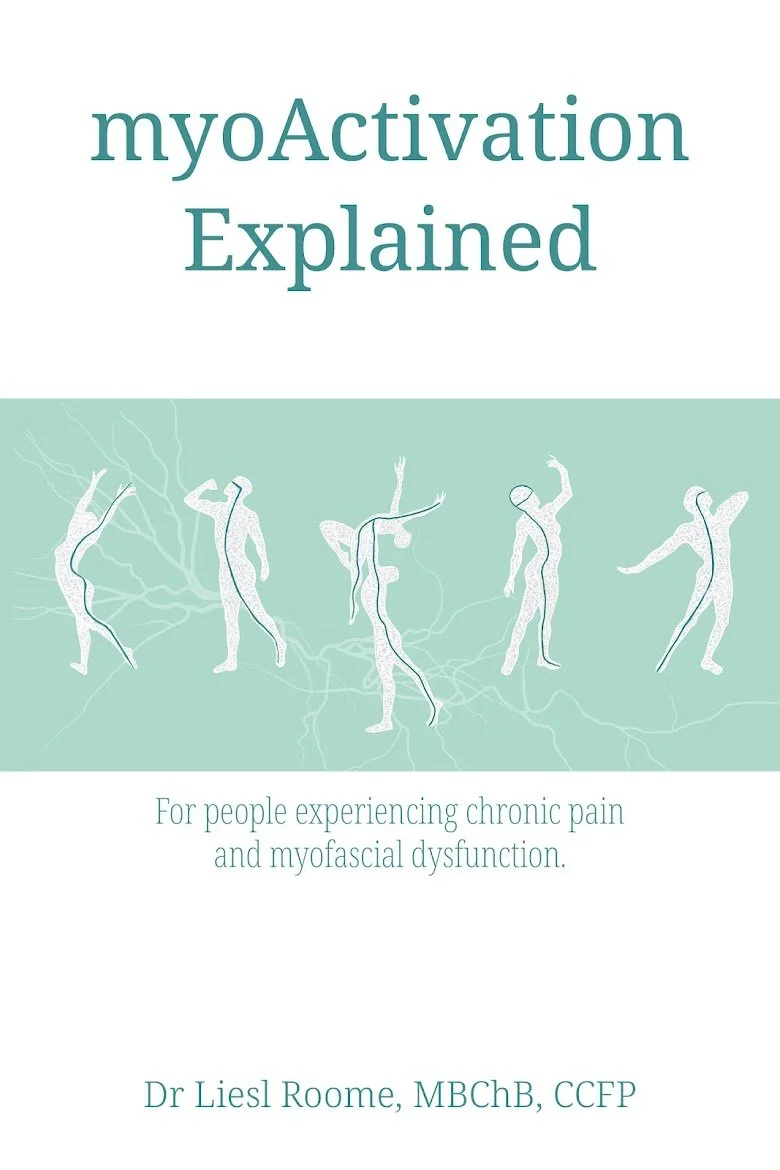For Patients
What is myoActivation®
The myofascial system in the body is made up of contractile muscle tissue and connective tissue.
myoActivation® is a unique structured system of assessment and treatment designed to reduce myofascial components of chronic pain. It’s distinguished from other treatments in the approach of identifying the source of the pain and the system of needling to release muscles in sustained contraction, fascia under tension, and relevant scars with the aim of resolving pain.
Who can benefit from myoActivation?
Most pain or movement issues are helped by myoActivation®. Common issues addressed are:
Back pain
Sciatica
Shoulder or hip pain/movement issues
Mobility and balance issues
Post surgery pain
Fibromyalgia
Headaches and migraines
Achilles tendinitis
Carpal Tunnel pain
And more!
The myoActivation Process
myoActivation® is a methodology that uses small hypodermic needles to release fascia overlying muscles and scars that are in sustained contraction.
The needle itself helps the area to release, often described as a ‘twitch’ like sensations as well creates a local inflammatory response to occurs which kickstarts the healing process.
The treatment consists of
Physical Exam and Assessment of Range of Motion (ROM)
Palpation (touch/feel of points of tenderness)
Needle Insertions
Re-assessment of ROM
The TiLT
Your practitioner will ask you questions to learn about your “Timeline of Lifetime Trauma” or TiLT. You will be asked about your current situation as well as events going back as far as your birth. Old injuries, both physical and emotional, are commonly at the root of pain that is experienced later in life. Examples are long forgotten childhood scars and tailbone injuries or repetitive strain from intense childhood sports activities. Some practitioners provide intake forms requesting this information in advance of your appointment.
FAQs
-
Complete any intake and consent forms your clinician requires
Review aftercare instructions, prepare for reduced activities after treatment
Dress appropriately
We recommend that you wear loose fitting clothing that will allow your clinician to access the areas of your body to be treated. For example:
Women - wear a sports bra or stretchy top with thin straps, and bring some shorts
Men - expect that you may be asked to take your shirt off, and bring some shorts
Long hair – please bring a hair clip that allows hair to be tied up
Tightness in the legs can have an impact on the whole body, bring some shorts so that your legs can be accessed if your examination indicates some of the issues are originating in your legs.
If you have arm or shoulder pain please wear a short sleeve or sleeveless shirt in stretchy fabrics. We also recommend you avoid wearing white or light coloured clothing (very rarely clothes may get stained from treatment).
Your clinician may have specific guidelines on how to prepare for your appointment - please check with them.
-
Muscle Fibre Release Sensation
This is a common and mild side effect. When muscles twitch and release you may feel momentary discomfort. The sensation varies with each individual. Patients have described the feeling as a pulling, tugging, burning, electrical or a “weird” sensation. Others feel a heat sensation or can feel the muscle twitch.
Muscle twitches, either observed or felt, give some biofeedback that muscle fibres are releasing. The greater the twitch, the more fibres are being released. Some releases are less noticeable as the muscle just softens.
Some patients experience a very brief radiation or an electrical feeling to a limb or up and down the body. This is a positive reaction indicating the release of fascial tissue associated with the treatment site. Sometimes, nerves can get tugged on in a moment as the muscle twitches, which can also send a signal. Usually these sensations only last a few seconds.
Bleeding and Bruising
The clinician selects needle size appropriate to the area being treated and always tries to limit the incidence of bleeding or bruising. Commonly, patients get tiny blood spots on the skin surface at insertion sites during treatment. These are inconsequential and resolve quickly with a bit of pressure.
It is very common for visible bruising to occur. If evident at the time of treatment, your clinician will apply direct pressure to reduce the risk of bruising.
If visible bruising occurs, your skin colour at the bruise site may change from black, or blue to yellow to green over 2 to 10 days. Occasionally the bruised appearance may extend downward from the needle insertion site as gravity results in blood tracking in the subcutaneous layers of tissue.
Bruised Sensation
Patients commonly experience a bruised feeling at the treatment sites, even if bruising is not visible. This sensation usually disappears within a day or two after treatment.
Fatigue
Patients who have a significant amount of muscle release may experience fatigue and feel an increased need for sleep.. This phenomenon is most common following the first treatment.
New patients may want to avoid driving immediately after their first treatment, especially if they know they are sensitive when it comes to needling modalities.
Pain Migration and Flare ups
Sometimes as patients get pain relief in the treated areas, they experience a migration of pain to new areas. Pain migration generally a positive sign in two ways:.
Muscle fibres treated are released and pain is resolved at that specific site. Sometimes, the patient has other longstanding muscle fibres in sustained contraction which were eclipsed by the pain from the treated areas. When the dominant painful area is resolved, other muscles in sustained contraction become evident. At follow-up treatment, please mention where things are hurting most and your clinician will start there and go layer by layer.
Sometimes new pain results from a realignment of the interrelated myofascial framework. The mechanism for this is unclear but may reflect disruption of the long established muscular interrelationships of shortened muscles that must readjust to a new normal. Generally, patients find their bodies adjust and pain disappears within a few days.
Less commonly, individuals may experience short-term worsening or a flare-up of pain following treatment which generally resolves within 24 hours. Please check with your clinician for re-assessment if a pain flare-up lasts more than 24 hours.
Lightheadedness or Dizziness
This is more likely to result in someone who has had previous history of similar symptoms following immunization or visualizing blood. Fainting or loss of consciousness is rare. In some cases the change in tension in the body can be a vagus nerve stimulant - which means blood pressure can drop temporarily, you could feel nauseous, sweaty or lightheaded and It is important to tell your treating clinician immediately if you feel any of these symptoms.
Feeling emotional
This is more likely when there is past trauma. After areas that were involved in trauma are released, you can feel emotional. Sometimes, it’s easy to remember what happened, or there can be a flashback. The body also holds our traumas, and physical release can give rise to emotional release, either at the time of treatment or after. Some just feel they are more emotional in the days following treatment. This is normal to experience. If you have had traumatic experiences, this would be a good time to work with a counsellor, to take extra time for processing, journalling, and meditative practices that are soothing and calming. Have low expectations on the day after treatment for how much you expect yourself to accomplish.
Rare Side Effects
Nausea
Rarely, a patient might experience nausea during or immediately post treatment. In very rare cases vomiting may occur. Please let your clinician know if you tend to have this kind of response to other treatments.
Infection
Clinicians assess each patient for infection risk and follow appropriate precautions according to best practices.
Overall, there is a very low risk of infection with myoActivation. The risk of infection can increase for patients with diabetes, immune-compromised states (during chemotherapy, immunological treatment for rheumatoid arthritis, organ transplant patients), or poor personal hygiene.
Possible signs of infection near the injection sites are increased pain, redness or swelling that begins within 24 hours, to a day or two after the injections. You should consult your clinician if you are concerned.
Shortness of Breath, Chest Pain or a Sudden Reduction in Exercise Capacity
These very rare symptoms may suggest a pneumothorax. Please call your clinician right away if you experience any of these symptoms. If after hours, seek treatment at an urgent care facility or emergency room. Note - this complication would only result where treatment was applied in skin over the lung fields, most likely in the upper back or lower neck area. Management of a pneumothorax would include getting an x-ray to assess the severity and for the most part monitoring for a few days while you breath out the little layer of air that got in between the lung and the pleura. Because the needle is a small gauge and the insertions are very quick, this should not require further procedures, but just time to resolve. In extremely rare cases, then an intervention, called a chest drain may be necessary to allow the lung to fully expand again, however this is extremely rare.
Symptoms and Signs That Need Urgent Medical Attention
If you experience any of the following symptoms within 72 hours following treatment, you need to be re-assessed as soon as possible:
shortness of breath, chest pain or sudden reduction in exercise capacity
fever
skin redness with swelling of superficial or deep tissues
fainting
Please call your clinician right away, or otherwise seek medical attention with your primary care provider, a walk in clinic, or the emergency room.
-
After treatment, it is important for patients to limit any activities and postures they spend prolonged periods of time in, and tune into how various activities and postures affect their symptoms. If you have had a good release, with improved symptoms after treatment, and you notice your body is tightening up again, stop what you’re doing and assess your posture and any repetitive movements over the previous hours. Consider reducing the intensity or duration of your activity, or modifying it so you can enjoy lasting results of your treatment.
Guidelines for Success
When in a prolonged posture, set a time to gently move any areas which were treated every 10-15 minutes. Avoid strenuous movement.
Gradually increase your activity by 10-20% percent as each day goes on. Start low, go slow and listen to your body.
It is human to want to jump to action after a long period of feeling unable to, but think of the restraint as an investment in yourself. Give your body the time it needs to heal, by pacing yourself.
-
More tips will be posted here when available.
Looking for more information?
There’s a handbook!
myoActivation Explained:
For people experiencing chronic pain and myofascial dysfunction
by Dr. Liesl Roome
with Dr. Gillian Lauder and Barb Eddy, NP
Chronic pain affects 1 in 5, disrupting everything from work to relationships and often pulling people into cycles of isolation and limited mobility. Treatment options are often hard to access and may involve heavy medications with mixed results.
As medical understanding of the myofascial system grows—a complex network of muscles, connective tissues, and sensory pathways in your body—new ways to treat chronic pain come to light. myoActivation is one such innovative treatment that targets scars, tense muscles, and distortions in fascial tissue to relieve pain, often faster than traditional methods. This accessible guide is for myoActivation patients and anyone curious about this approach.
It explains:
• What myoActivation is and who it can help
• How it can help relieve chronic pain
• What to expect as a patient and how to prepare
• Tips for maintaining results and avoiding re-injury
• Extra guidance for patients with other health considerations
• Further resources for learning and support
As one patient put it, “You have nothing to lose but your aches!”

